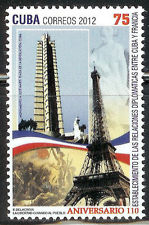The stamps of a country tell the country’s history, showing what and who are important at a given snapshot in time. Postage stamps showcase different styles of art as well as different artistic designs. Styles and depictions give unique clues to a c
The colonization of Cuba by Spain began back in 1511, and it took place at a leisurely rate. It wasn’t until the mid 1700s that an internal mail service was created. It laid out postal routes between the major cities of Cuba: Bayamo, Puerto del Principe, Sancti-Spiritus, Santa Clara, Matanzas, Guanbacoa, Santiago de Cuba, and Havana. The pace of mail was leisurely too. Mail would leave Havana destined for one of the other cities on the first day of the month, and mail would be brought back on a date toward the end of the month. Havana to Santiago de Cuba was a journey of 550 miles, so it is no wonder it took a long time.
At the time there were no stamps or postmarks, and mail was either sent paid or unpaid. Unpaid mail required the recipient to pay the postage upon receipt. It wasn’t until 1760 that the first postal marking was used on Cuban mail, when a town mark was made for Havana. In the late 1760s, bronze town marks were given to several of the major Cuban cities as well. New towns added to postal routes received their own postmarks to be used for dispatching mail.
In 1877, Cuba issued its first stamp bearing its own name. Until that time, Cuban stamps did not give the name of the Spanish colony where they were made and used. At this time, Spain’s ruler was King Alfonso XII, and his picture adorned the new Cuban stamps.
After the Spanish American War ended, the U.S. ended its occupation of Cuba and turned over Cuban postal affairs to Colonel Fernando Figueredo Socarras, Cuba’s first postmaster general. Cuba ordered its supplies of postage stamps, post cards, and stationery from the U.S. Bureau of Engraving and Printing until Cuba got its own postal production going.
After the Cuban revolution of 1959, hundreds of thousands of Cubans fled the island for America. Fidel Castro aligned his policies closely with that of the Soviet Union, who established a significant military presence on the island. The U.S. imposed a trade embargo on Cuba in 1962. Though in the 2000s, Cuba has made small steps to liberalize the economy, and loosen some emigration restrictions, the embargo remains in place in the U.S. as of 2009, and it remains illegal to bring Cuban postage stamps into the U.S. through the U.S. postal system.





